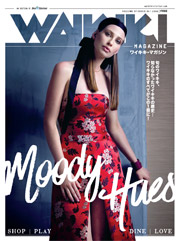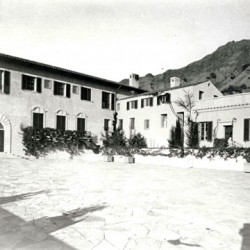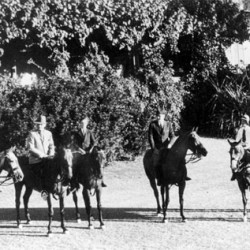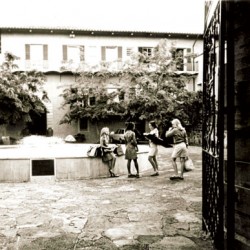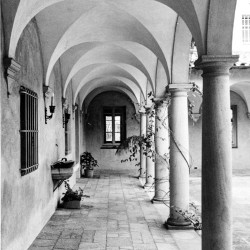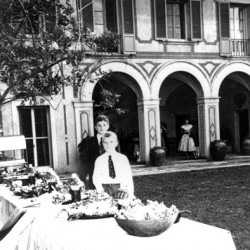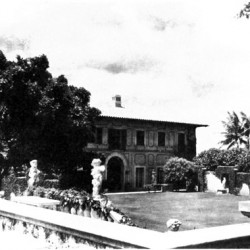Diamond Head Haven
Lookout point-turned sacrificial site-turned superb school—the grounds of La Pietra possess a colorful past.
From a sacrificial heiau, to an industrialist family’s mocked mansion, to a faculty lodging facility for one of Hawai‘i’s most prestigious schools, the acreage where all-girls school, La Pietra now sits, nestled on the slope of Diamond Head (Le Ahi) couldn’t be a more storied site.
Under its former name, Hawaii School for Girls, the school was moved from its original location at Central Union Church in Honolulu to its current location in 1969 on Poni Moi Street, above the foot and rubber traffic of Kapi‘olani Park. Since and for the past 40-plus years, La Pietra Hawaii School for Girls, has served as a peaceful and encouraging learning environment, where gratitude is never a hard-pressed commodity, given the views of open ocean the girls are captivated by on any given school day.
Yet, before there were school bells, or in La Pietra’s case, an old ship bell, the land went through many passages of time and culture. Before its dismantling in the late 19th century, Papa‘ena‘ena heiau or stone temple—constructed by lava stone at an estimated 130 by 70 feet—has been noted by researchers to have been used by Hawaiian monarchy for various reasons. Papa‘ena‘ena was used as an observation lookout, relaying information via kite signals. The heiau was also used religiously as a sacrificial site where King Kahekili and King Kamehameha I offered gifts—in the form of human life to various gods, including god of war, Kuku‘alimoku.
In the early 20th century, as the native Hawaiian culture began to be overtaken by missionaries and a migrating populous, Honolulu’s downtown financial and industrial district was gaining massive attention and a bustling city pulse was starting to beat.
Benjamin Franklin Dillingham, proprietor of Oahu Railway and Land Company was a major industrial player in the center of Honolulu’s expansion. In 1909, Dillingham’s son, Walter—who founded Hawaii Dredging Construction Company—agreed to a contract to begin excavating Pearl Harbor. Upon completion, Dillingham had 15 acres of dredge-fill laid into the marshland that is now Waikiki. Around the same time, Walter married Louise Olga Gaylord, and the young couple honeymooned at Louise’s family estate, La Pietra villas just outside Florence, Italy.
With a desire to bring a Mediterranean-style home to Hawai‘i, Louise and Walter chose the family’s newly acquired Diamond Head property as the place for their new home.
“Louise wanted not so much a replica, but a composite of the different features of Florentine villas that she had seen. When they decided where to build, they became the laughing stock of Honolulu because that area was [considered] “the sticks.” All the wealthy families had their estates in Manoa or Tantalus,” says teacher and administrator Sandy Robinson, who has been with La Pietra School for Girls for over 30 years.
Regardless of popular opinion, the Dillinghams hired Chicago architect David Adler to design their home and by 1920, construction of what would become one of Diamond Head’s first luxury estates was underway.
Not strapped for space, the Dillingham’s villa-style chateau was lavish, yet tasteful with finely designed stenciling in each original wall. It featured five bedrooms, pool, courtyard and a large lawn lined with imported olive trees and statues including a sarcophagus dating back to the first century. Attached were visiting quarters, servant rooms as well as stables and locker rooms for polo matches, which were hosted just below in the then-newly developing Kapi‘olani Park.
The Dillinghams hosted many cultural and political icons including, Prince Edward, King of Siam, Walt Disney and Franklin D. Roosevelt. “The entire area was theirs,” says Robertson. “The Royal Hawaiian and Moana Surfrider hotels may have been the only structures that they would have seen when the estate was built.”
After Dillingham’s passing in 1963, much of the property was bequeathed to Punahou School for faculty housing. With not much of a need for the estate, Punahou rented and gradually sold the property rights to La Pietra founders Lorraine Day Cooke and Barbara Cox Anthony. In 1969, La Pietra Hawaii School for Girls had a permanent location as headmaster Joseph Pynchon looked over 210 enrolled, young women.
Of course, renovations have been made throughout the estate. One in particular is the transformation of Walter Dillingham’s master bedroom into sectioned-off classrooms, each with breathtaking views of Waikiki and the ocean below. Aside from being the grounds for the exclusive school, certain parts of the La Pietra campus are available for private events as well. Its beautiful landscape and serene environs are frequently used as the backdrop for weddings and other special occasions. “In times of duress, this has been a peaceful place of contemplation,” says Robinson. So whether La Pietra student, history buff or future bride, many can experience the grand grounds of this historic property.
La Pietra Hawaii School for Girls
2933 Poni Moi Road
(808) 922-2744
www.lapietra.edu
Photos courtesy of Bishop Museum
- La Pietra was built in 1919-1920. The estate was modeled after the villa La Pietra, a Gaylord family villa in Florence, Italy.
- The Dillinghams and friends gathered on their front lawn for a polo match in Kapi‘olani Park. The horses were an important part of their life, as they enjoyed polo matches.
- The Julie Brown Courtyard
- Inside the courtyard at La Pietra
- The lawn made the perfect setting for a party, pictured here are two Dillingham boys, Lowell and Ben.
- A view of the estate from the tennis court



